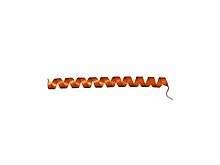Ena/Vasp homology proteins
ENA/VASP homology proteins or EVH proteins are a family of closely related proteins involved in cell motility in vertebrate and invertebrate animals. EVH proteins are modular proteins that are involved in actin polymerization, as well as interactions with other proteins. Within the cell, Ena/VASP proteins are found at the leading edge of Lamellipodia and at the tips of filopodia.[1] Ena, the founding member of the family was discovered in a drosophila genetic screen for mutations that act as dominant suppressors of the abl non receptor tyrosine kinase. Invertebrate animals have one Ena homologue, whereas mammals have three, named Mena, VASP, and Evl.
| Ena/Vasp homology proteins | |
|---|---|
 Domain organisation of EVH proteins | |
| Identifiers | |
| Symbol | VASP/EVL |
| InterPro | IPR017354 |
| VASP tetramerisation domain | |||||||||
|---|---|---|---|---|---|---|---|---|---|
 human vasp tetramerisation domain l352m | |||||||||
| Identifiers | |||||||||
| Symbol | VASP_tetra | ||||||||
| Pfam | PF08776 | ||||||||
| InterPro | IPR014885 | ||||||||
| |||||||||
Ena/VASP proteins promote the spatially regulated actin polymerization required for efficient chemotaxis in response to attractive and repulsive guidance cues. Mice lacking functional copies of all three family members display pleiotropic phenotypes including exencephaly, edema, failures in neurite formation, and embryonic lethality.
A sub-domain of EVH is the EVH1 domain.
VASP
Vasodilator-stimulated phosphoprotein (VASP) 45-residue-long tetramerization protein domain which regulates actin dynamics in the cytoskeleton. This is vital for processes such as cell adhesion and cell migration.[2]
Function
Vasodilator-stimulated phosphoprotein (VASP) is an actin cytoskeletal regulatory protein. VASP is often found in dynamic actin structures like filopodia and lamellipodia, but its precise function in their formation is controversial. VASP accelerates filament elongation by delivering monomeric actin to the growing barbed (+) end.[3]
Structure
The tetramerisation domain has a right-handed alpha helical coiled-coil structure.[4]
References
- Bear and Gertler; Gertler, FB (2009). "Ena/VASP: towards resolving a controversy at the barbed end". J Cell Sci. 122 (Pt 12): 1947–53. doi:10.1242/jcs.038125. PMC 2723151. PMID 19494122.
- Wu, Yidi; Gunst, Susan J. (1 May 2015). "Vasodilator-stimulated Phosphoprotein (VASP) Regulates Actin Polymerization and Contraction in Airway Smooth Muscle by a Vinculin-dependent Mechanism". Journal of Biological Chemistry. 290 (18): 11403–11416. doi:10.1074/jbc.M115.645788. PMC 4416845. PMID 25759389.
- Breitsprecher D, Kiesewetter AK, Linkner J, Urbanke C, Resch GP, Small JV, Faix J (2008). "Clustering of VASP actively drives processive, WH2 domain-mediated actin filament elongation". EMBO J. 27 (22): 2943–54. doi:10.1038/emboj.2008.211. PMC 2585163. PMID 18923426.
- Kühnel K, Jarchau T, Wolf E, Schlichting I, Walter U, Wittinghofer A, Strelkov SV (December 2004). "The VASP tetramerization domain is a right-handed coiled coil based on a 15-residue repeat". Proc. Natl. Acad. Sci. U.S.A. 101 (49): 17027–32. doi:10.1073/pnas.0403069101. PMC 535362. PMID 15569942.